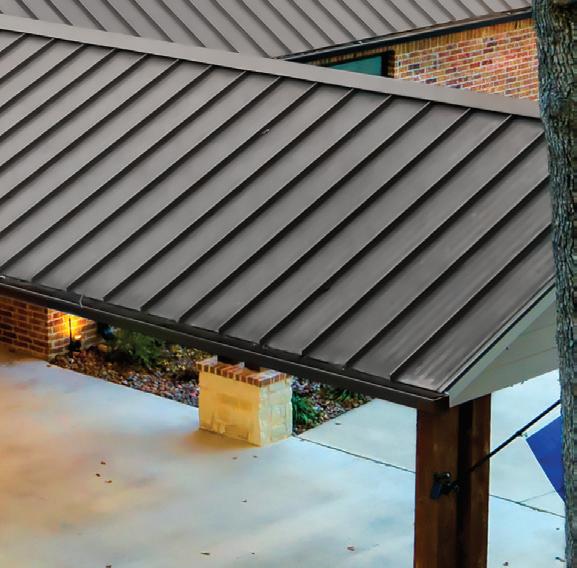












































































It is no surprise that today’s energy industry is ever-changing. Louisiana electric co-ops are leaning into change as we explore new ways to meet our members’ ever-changing needs adequately and efficiently.
The primary responsibility of electric cooperatives is to our member-owners. This responsibility extends beyond merely ensuring the lights come on when the switch is flipped. Cooperatives remain committed to providing safe, reliable, affordable electric service while simultaneously adopting energy policies that further these goals.
Speaking to reliability, the North American Electric Reliability Corp., the watchdog for the nation’s grid, has issued several warnings about threats to grid reliability. Specifically, NERC warns rolling blackouts will become a new norm. To that end, nine states experienced blackouts in 2022 when electricity supply could not meet demand.
Over the next five years, NERC forecasts that all or parts of 19 states from Montana to Louisiana are at high risk of rolling blackouts during normal peak conditions. NERC’s 2023 Summer Risk Assessment will come out later this month.
Against this backdrop, electric cooperatives are pressing policymakers to recognize the need for more time, technology development and new infrastructure, alongside policies that include diverse energy sources to maintain reliable power.
As is evident in today’s society, the economy
continues to rely heavily on electricity. From data centers and manufacturing to electric vehicles and electric heat pumps, electricity demand is set to rise dramatically.
Electric co-ops are planning for this surge in demand by investing in infrastructure to make it more reliable and resilient. Additionally, cooperatives are applying for grants with the Department of Energy.
In addition to grid investments, cooperatives around the state continue to implement new technologies such as automated metering infrastructure and outage reporting systems. Louisiana electric cooperatives have also signed new wholesale power supply contracts that will change how cooperatives buy the power we distribute to you, our member-consumers.
Despite this increasing electricity demand, many power plants that generate alwaysavailable electricity are being shut down without adequate replacements, posing a significant threat to reliability. The Environmental Protection Agency is pursuing sweeping new regulations that would force the premature closure of always-available power plants while making permitting, siting and building critical new plants harder.
Electric co-ops have urged the EPA to withdraw these proposed regulations, which could lead to more blackouts, higher costs and uncertainty for cooperative members.
To ensure electricity remains safe, affordable and reliable, electric co-ops are at the forefront of innovation and are already adapting to the
Staff
CEO Addie Armato
DIRECTOR OF LOSS CONTROL Aarron Graham
SAFETY COORDINATOR Ricky Melancon
COMMUNICATIONS AND DIGITAL MARKETING
SPECIALIST Conley Bourgeois
ADMINISTRATIVE ASSISTANT Rhianna Garon
CREDIT UNION
Robin Plunket, manager
Jody Overhultz, representative
Board of Directors
President Dennis Glass
Vice President Michael Heinen
Secretary/Treasurer Roger Dale DeHart


ALEC Members
BEAUREGARD ELECTRIC COOPERATIVE INC.
Trent Buxton
CLAIBORNE ELECTRIC COOPERATIVE INC.
Mark Brown Lane Davidson
DEMCO
Daniel Berthelot Richard “Dickie” Sitman
JEFF DAVIS ELECTRIC COOPERATIVE INC.
Michael Heinen Byron Hardee
SOUTH LOUISIANA ELECTRIC COOP ASSOCIATION
Trevor Benoit Roger Dale DeHart
WASHINGTONST. TAMMANY ELECTRIC COOP INC.
Joe Jarrell Dennis Glass
Associate Member
PANOLAHARRISON ELECTRIC COOPERATIVE INC.

unique needs of the members we serve. Co-ops are leading the way by adding solar projects to their power supply portfolios and providing members with energy efficiency programs and cost-cutting tips.

Last month, your Louisiana electric cooperative leaders gathered in Washington, D.C., for the annual Legislative Conference, where they met with members of Congress and federal agencies to discuss critical issues and concerns surrounding reliability.
Leaders of your Louisiana electric cooperatives educated policymakers on the issues that matter most to the Louisiana families and businesses we serve, such as our opposition to the EPA’s current power plant rule, protecting USDA funding for electric cooperatives, alleviating supply chain challenges, safeguarding the rural electric cooperative infrastructure and Federal Emergency Management Agency reform. Because energy decisions and policies made today determine whether there are enough resources to meet tomorrow’s energy needs, electric co-ops must continue advocating for their members to ensure a reliable supply of electricity that powers everyday life.
Source: www.nerc.com/pa/RAPA/ra/ Reliability%20Assessments%20DL/NERC_ SRA_2022.pdf#search=louisiana%20high%20risk






906 N. Lake Arthur Ave.
P.O. Box 1229
Jennings, LA 70546
337-824-4330 • 337-824-8936 (fax)
Branch office:
815 Hwy. 27, Bell City, LA 70630
337-598-5700
www.jdec.org
STAFF
Michael J. Heinen | CEO
Anya Killmer | Executive Assistant/ Benefits/HR
Eric Gautreaux | Chief Operating Officer
Tara Guinn | Chief Financial Officer
Skyler Hebert | Office Manager
Ben Hetzel | Director of Safety/ Member Services
Brennon LaBouve | Engineering Manager/ Substation & Metering
Heath Lemieux | Superintendent
Kain Miller | Superintendent, Jennings
Jonathan Nunez | Superintendent, Hackett
Wendell Thibodeaux | Purchasing Manager/ Warehouse
BOARD OF DIRECTORS
Joseph L. Tupper | President
Thomas Precht III | First Vice President
John Berken | Secretary/Treasurer
James Doxey
Byron Hardee
Wilson Dean Landry
Reggie Murphy
Kevin Sonnier
Martin Zaunbrecher
Volume 41, Issue 3
Louisiana Country (USPS 473-180) is published bimonthly by the Association of Louisiana Electric Co-ops Inc., 10725 Airline Hwy., Baton Rouge, LA 70816, in partnership with Pioneer Utility Resources.
Annual subscriptions: Members $2.30. Nonmembers $5.
Postmaster: Send form 3579 to 10725 Airline Hwy., Baton Rouge, LA 70816.
Periodicals postage paid at Baton Rouge, Louisiana 70821, and additional mailing offices.
Annual Meeting of the Membership
Monday, July 8
Registration opens at 8 a.m. Meeting begins at 10 a.m.
Jennings High School, 2310 N. Sherman St., Jennings, LA 70546
Hear reports about your cooperative, see informational presentations and have the chance to win prizes. We look forward to seeing you there.
To better facilitate your registration at the Jeff Davis Electric Co-op Annual Meeting, please take a few minutes ahead of the meeting to help us ensure you are correctly listed in our records.
Check the name or names listed on the mailing label on the front of this magazine. This is how your account is listed in our records. If there have been changes, please contact us with your updated information.
Your registration is important for the prize drawing at the end of the business session.
Only members may register at the meeting. The c/o name listed on the mailing label is not the member. A joint membership of husband and wife counts as one registration. A tenant may not register
In some cases, members have failed to update their accounts or have left an account in the name of a deceased parent, spouse or former tenant.
Be sure your account is listed in your current, legal name. If not, it should be changed immediately.
A qualified representative of a church, business or organization may register if proper documentation is presented. Only the president, officer or manager of a corporation may vote on behalf of the corporation at a meeting of the members.
However, by corporate resolution of the organization’s board of directors, any employee of the corporation may be designated to vote on behalf of the corporation. This resolution must be adopted at least 90 days before the annual



Cleco Cajun LLC
Proud to serve
Beauregard, Claiborne, Concordia, Jefferson Davis, Northeast, Pointe Coupee, SLECA, SLEMCO and Washington-St. Tammany electric cooperatives.
Proud to serve
Beauregard, Claiborne, Concordia, Jefferson Davis, Northeast, Pointe Coupee, SLECA, SLEMCO and Washington-St Tammany electric cooperatives
Section 1. GENERAL POWERS. The business and affairs of the Cooperative shall be managed by a Board of nine directors, which shall exercise all powers of the Cooperative except such as are by law, the Articles of Incorporation of these Bylaws conferred upon or reserved to the members.
Section 2. QUALIFICATIONS. No person shall be eligible to become or remain a director or to hold any position of trust in the Cooperative who: (a) Is not a member of the cooperative and bona fide domiciliary in the district he is to represent; or (b) Is in any way employed by or financially interested in a competing enterprise or a business selling electric energy or supplies to the Cooperative or a business primarily engaged in selling electrical or plumbing appliances, fixtures or supplies to the members of the Cooperative; (c) No person may be eligible to serve as a director who is the incumbent of or candidate for an elective public office in connection with which a salary in excess of $500.00 per annum is paid; and (d) No person may be eligible to serve as a director who has been an employee of the cooperative within three (3) years from the last date of his or her employment.
Upon establishment of the fact that a director is holding office in violation of any of the foregoing provisions, it shall become incumbent upon the Board of Directors to immediately remove such director from office. Nothing contained in this section shall affect in any manner whatsoever the validity of any action taken at any meeting of the Board of Directors.
Section 3.
(a) NOMINATIONS, ELECTION AND TENURE IN OFFICE. It shall be the duty of the Board of Directors to appoint not less than 60 days or more than 90 days before the date of the meeting of Members at which Directors are to be elected a committee on nominations consisting of not more than the number of Directors to be elected, which committee members shall be selected one from each of the districts of the area served by the Cooperative from which a director is to be elected at the ensuing meeting. No member of the Board of Directors may serve on such committee. The committee shall prepare and post at the principal office of the Cooperative at least fifty (50) days before the meeting a list of nominations for directors. Any fifteen (15) or more members acting together may make other nominations by petition not less than forty (40) days prior to the meeting, and file petition with the Secretary, and the Secretary shall post such nominations at the same place where the list of nominations made by the committee is posted. The Secretary shall mail with the notice of the meeting or separately, but at least thirty (30) days before the date of the meeting, a statement of the number of directors to be elected and the names and addresses of the candidates. The names shall be arranged by districts and shall specify separately the nominations made by the committee on nominations and also the nominations made by petition, if any. Notwithstanding anything contained in this section, failure to comply with any of the provisions of this section shall not affect in any manner whatsoever the validity of any election of directors.
(b) ELECTION AND TENURE. In the year 1979, nine board members shall be elected to office. Each board member shall represent one of the nine districts, and shall be elected in conformance with procedures as hereinafter described except that the term of office for each will be as follows: The board members representing Districts 1, 4 and 7 shall each be elected to serve until the annual meeting to be held in the year 1980 or until their successors shall have been elected and shall have qualified.
The board members representing Districts 2, 5 and 8 shall be elected to serve until the annual meeting to be held in the year 1981 or until their successors shall have been elected and shall have qualified. The board members representing Districts 3, 6 and 9 shall be elected to serve until the annual meeting to be held in the year 1982 or until their successors shall have been elected and shall have qualified. Beginning in the year 1980, three board members shall each be elected for a three-year term to fill vacancies caused by expiration of the incumbents’ terms of office.
To win a prize, business accounts must be represented by an authorized officer of the firm or organization.
The bylaw regarding firms and associations reads: “A duly authorized officer of any firm, corporation, partnership, association or political body may, upon proper proof of his authority, claim a prize for his firm or group.”
Before the meeting, firms must furnish an authorization to Jeff Davis Electric Cooperative Inc. These rules are consistent with the co-op’s bylaws.
To claim a prize, you must be at least 18 years of age, be the member or spouse of the member and furnish proof of membership by the registration card provided to you. Only one card for each member is eligible, even though a member may have several meters.
You cannot claim a prize for any account but your own.
In accordance with the bylaws of Jeff Davis Electric Cooperative Inc., the Nominating Committee appointed by the board of directors will meet at the cooperative office in Jennings, Louisiana, 906 Lake Arthur Ave., at 9 a.m. May 13, 2024.
Board members running for reelection this year are:
X John Berken, District 3.
X Martin Zaunbrecher, District 6.
X James Doxey, District 9.



Altec, Altec Capital, Altec Truck, Altec Sentry, JJ Kane, Osmose and Tempest will award seven $500 scholarships for fall 2024 at the Association of Louisiana Electric Cooperatives’ annual meeting in July.
The following rules apply:
• Applicant must be the child of an ALEC member cooperative, including Beauregard Electric, Claiborne Electric, DEMCO, Jeff Davis Electric, Panola-Harrison Electric, South Louisiana Electric or WashingtonSt. Tammany Electric.
• Applicant must be a 2024 high school graduate.
• Applicant must provide verification of a minimum 2.0 GPA before scholarship is awarded.
• This is a one-time award.
• The award can be used for any college or university.
Application and current transcript must be postmarked by June 30, 2024. Altec is not responsible for mail delivery. Mail to Ed Amedee, 1443 City Place, Gonzales, LA 70737.
Name of applicant: ______________________________________
Name of parent or guardian: ______________________________
Member co-op: _________________________________________
Address: ______________________________________________
City: ____________________________ Zip code: ___________
Phone number: ________________________________________
Name of high school: ____________________________________
Donate $1 to the Sandy Stockwell Cooperative Youth Leadership Scholarship Fund, and you could win a portable Hisencn flat top propane grill.
To buy a ticket, visit your electric cooperative.
The drawing is in July at the Association of Louisiana Electric Cooperatives’ annual meeting banquet in Baton Rouge.
You do not need to be present to win. The winner will be contacted by phone.




May is Electrical Safety Month!
Read the safety tips below, then nd and circle all the bolded words in the puzzle.
• Do not use any electrical cords that feel warm to the touch or are damaged in any way.
• Remind parents or adults in your home to test smoke alarms every month. Alarms should be installed in every bedroom, outside each sleeping area and on every level of your home.
• Do not overload electrical outlets. Overloading creates a potential fire hazard.
• Keep all liquids away from electronics, including TVs, computers and gaming consoles.
• Do not run electrical cords under rugs or carpet. This creates a fire risk





Everyone feels the hurt as you age, but CBD can help you deal with it.
BY BETH GILES
Life really does y by. Before I knew it, my 60s had arrived, and with them came some new gi s from dear ol’ Mother Nature—frequent knee pain, stress, low energy and sleeplessness. Now, I’m a realist about these things, I knew I wasn’t going to be young and springy forever. But still, with “golden years” nearly on my doorstep, I couldn’t help but feel a little cheated. at is until I found my own secret weapon. Another gi from Mother Nature. It began a few months back when I was complaining about my aches and pains to my marathon-running granddaughter, Jen. She casually mentioned how she uses CBD oil to help with her joint pain. She said that CBD gave her more focus and clarity throughout the day and that her lingering muscle and joint discomfort no longer bothered her. She even felt comfortable signing up for back-to-back marathons two weekends in a row this year. at made even this self-proclaimed skeptic take notice.
But I still had some concerns. According to one study in the Journal of the American Medical Association, 70% of CBD products didn’t contain the amount of CBD stated on their labels. And, as a consumer, that’s terrifying!
If I was going to try CBD, I needed to trust the source through and through. My two-fold research process naturally led me to Zebra CBD. First, I started calling my family and friends. Call me old fashioned but I wanted to know if there were people whom I trusted (more than anonymous testimonials) who’ve had success using CBD besides my granddaughter. Secondly, I wanted cold hard facts. Diving
deep into the world of CBD research and clinical studies, I came across Emily Gray M.D., a physician at the University of California at San Diego (UCSD) Medical School and medical advisor to Zebra CBD who is researching the e ects of CBD. Dr. Gray wrote “early results with CBD have been promising and we have a lot of research underway now. I’ve had several patients using CBD with good success. It’s important that you know your source of CBD and how to use it properly.”
A er hearing it from the doctor’s mouth, I returned to my research, asking more people and was amazed by the number of close friends and family who were already on the CBD train. Apparently, I was the only one without a clue! And funny enough, a couple of friends who commented were using the same brand as my granddaughter—Zebra CBD. ere was no consensus as to why they were using CBD, but the top reasons given were for muscle & joint discomfort, mood support, sleep support, stress and headaches, as well as supporting overall health & wellness.
Eventually, even the most skeptical of the bunch can be won over. With a trusted CBD source in mind, I decided to give it a go.
When I viewed Zebra CBD’s selection online, I was impressed by its array of products, including CBD oils called tinctures, topicals, chewable tablets, mints and gummies. A er reading on their website that all their products are made with organically-grown hemp, I ordered... and it arrived within 2 days!
e rst product I tried was the Rub. Now this stu was strong. Immediately a er rubbing
it on my knee, the soothing e ects kicked in. It had that familiar menthol cooling e ect, which I personally nd very relieving. And the best part is, a er two weeks of using it, my knee pain no longer a ected my daily mobility.
e Zebra Mint Oil, on the other hand, had a di erent but equally positive e ect on my body. To take it, the instructions suggest holding the oil in your mouth for about 30 seconds. is was simple enough, and the mint taste was, well, minty. A er about 15 minutes, a sense of calm came over my body. It’s hard to describe exactly. It’s more like an overall sense of relaxation—as if I just walked out of a spa, and now I’m ready to seize the day. Needless to say, I’ve really enjoyed the oil.
While it hasn’t been a catch-all x to every one of my health issues, it has eased the level and frequency of my aches. And it sure doesn’t seem like a coincidence how much calmer and more focused I am.
All-in-all, CBD is one of those things that you have to try for yourself. Although I was skeptical at rst, I can safely say that I’m now a Zebra CBD fan and that I highly recommend their products.
Also, I managed to speak with a Zebra CBD spokesperson willing to provide an exclusive o er. If you order this month, you’ll receive $10 o your rst order by using promo code “IL10” at checkout. Plus, the company o ers a 100% No-Hassle, Money-Back Guarantee. You can try it yourself and order Zebra CBD at ZebraCBD.com/Louisiana or at 1-888-762-2699.
















One hot afternoon, we struggled to find fish

noticed some activity up ahead. In a stretch of cypress-lined shoreline about 20 yards long, water boiled with activity.
A sight any fly fisherman longs to see, millions of newly hatched mayflies covered the branches and bushes. Below the branches overhanging this bayou, the water churned as if frenzied piranhas were devouring a bleeding water buffalo. Fish of every species annihilated anything that touched the water.

anchor nor trolling motor. In addition, the ancient 12-foot aluminum boat leaked so badly we had to bail it with a gallon milk jug about every 30 minutes just to stay
My fishing partner and I immediately whipped out our fly rods and dropped cork poppers into the ruckus. Unfortunately, a roaring wind made stopping to fish the honey hole impossible. We had neither an afloat.


Still, we formulated a plan. Fortunately, the wind blew parallel to the bank where we wanted to fish. I cranked up the also-ancient 6-horsepower outboard and headed into the wind while my buddy bailed the boat. We stopped far enough past the sweet spot to get our gear ready for a quick drift, and by “quick,” I mean the brutal wind hurtled us past the bushes nearly as fast as the old motor could push us when it cranked.
We furiously made a cast or two as we shot past the strike zone, hoping we didn’t snag on anything. If the floating artificial bug hit the honey hole, a big bluegill or other fish instantly blasted it. If the bug





missed the sweet spot, nothing happened.
About the time we shot past where we wanted to be, the boat needed bailing again. We bailed the boat dry—or at least as dry as we could for something that resembled a noodle strainer with a motor—and hoped the old engine would crank again. Fortunately, it did. We ran the outboard upwind past the bug-laden bushes to make another drift. We repeated this effort many times that late spring afternoon until we grew tired of catching fish—and bailing.




Also called willow or shad flies, mayflies spend most of their lives underwater as nymphs. Called naiads in their aquatic form, the insects look somewhat like elongated or flattened crickets or a cross between a cricket and a shrimp.
When the weather turns warmer in late spring and summer, naiads sprout wings








and emerge from the water. After emerging from the water, millions of flies cling to tree branches, low bushes, reeds or whatever else they can find to dry their new wings before taking flight. Thousands inevitably fall into the water, attracting every fish in the area.



An adult mayfly resembles a giant mosquito waiting to bite. That scares some people. Fortunately, adult mayflies cannot bite anything. The adult flies don’t even have functional mouths, so they can’t eat, bite or sting anything. Mayflies belong to the insect order Ephemeroptera, which means “lasting only a day.” The winged adult form simply exists to procreate. They live just long enough to breed, if they make it that long. After mating, the flies die, adding more protein to the food chain.

Hatches—technically just bugs changing from aquatic nymphs into winged adults— normally occur in sluggish eddies or placid backwaters of freshwater systems. When they pop out as winged adults, the insects create massive swarms numbering in the millions or even billions of individuals. Sometimes, swarms grow so large that they show up on radar.
On July 3, 2020, a gigantic swarm appeared on National Weather Service radar 50 miles away and blanketed Burlington, Iowa. In June 2015, a hatch along the Susquehanna River near Columbia, Pennsylvania, grew so thick that police had

to close the bridge over the river because motorists couldn’t see. In 2014, a hatch on the upper Mississippi River near La Crosse, Wisconsin, reached an altitude of 2,500 feet. On radar, it resembled a significant rainstorm. Sometimes, northern communities use snowplows to push piles of dead insects off bridges so people can drive safely.
When flies fall on the water’s surface, they float. Copious amounts of free protein suddenly entering the food chain kick off a major feeding frenzy that attracts every fish around. Anyone who happens upon a hatch could load a boat with bluegills and other fish quickly—assuming they can stay in a good casting spot.
For the most fun, toss small poppers on light fly tackle. Floating insect imitations made of cork, foam, wood or plastic, often adorned with feathers and rubber “legs,” make excellent bream enticements. Some creations resemble crickets, grasshoppers or other creatures that bluegills love to eat.




Besides fly tackle, anglers can catch bream on other baits and lures. Many people fish with small beetle spinners around a hatch or hop jigs along the bottom.
Bass anglers can also benefit from a mayfly hatch. Some bass eat the insects, but larger bass gather to feed on swarming bluegills. For bass, fish crankbaits or spinnerbaits in bluegill colors or drag soft plastics under the bushes.


In a mayfly hatch, lure selection doesn’t matter as much as placement. Cast a temptation as close to fly-laden bushes as possible without snagging. If the bug hits the hot zone, something should grab it instantly. If it falls outside the sweet spot, don’t waste time. Make another cast. If the frenzy dies down, shake the bushes to make more flies fall into the water and reignite the frenzy or look for another hatching swarm.



Depending on the location, hatches in Louisiana might erupt anytime from late March through early November. The peak hits from late June to mid-September. Anglers never know exactly when or where a major hatch might erupt, but anyone lucky enough to find one in progress never forgets the experience. A bug hatch can turn an otherwise humdrum day into an incredibly memorable and productive occasion.











There’s a reason Louisiana is nicknamed Sportsman’s Paradise. And we’re not just talking about hunting and fishing, although those are major draws. Louisiana offers a slew of outdoor activities, including canoeing, kayaking, hiking, birding, biking and wildlife viewing. There’s even the chance to sunbathe on pristine beaches and swim in warm Gulf waters.
Birds and Beaches: Creole Nature Trail All-American Road
There’s something for everyone on the Creole Nature Trail, known as Louisiana’s Outback. There’s fishing, crabbing, hiking and birdwatching—as many as 400 bird species frequent the area. Also, the trail has one of the state’s largest populations of easily viewable alligators. Visitors can spot gators sunning themselves right alongside the road.
Exit Interstate 10 at Sulphur and check out Creole Nature Trail Adventure Point, where interactive exhibits explain the trail’s

wildlife refuges, rookeries, fishing opportunities and beaches where the trail hits the Gulf. Grab a map and head south.
The trail is a stopping point for thousands of migratory birds and millions of butterflies along the Trans-Gulf migration path. It’s routinely named one of the finest birdwatching spots in the nation. At the center of the migration path on the edge of the Gulf of Mexico lies Peveto Woods Sanctuary, a habitat run by the Baton Rouge Audubon Society.
The Creole Nature Trail includes three national wildlife refuges and one state refuge. The Cameron Prairie National Wildlife Refuge lets visitors explore a freshwater marsh and learn more in its visitors center. The 3-mile Pintail Wildlife Drive and half-mile boardwalk are ideal for birdwatching and other adventures.
For those wanting to see gators, the Rockefeller Wildlife Refuge offers the highest alligator nesting densities in the United States. There are many places to fish and crab throughout the











region, and hunting opportunities include deer, geese, ducks, dove and other game.
At the bottom of the trail, at the south end of the loop, are 26 miles of accessible Gulf Coast beaches, such as Rutherford Beach and Holly Beach. Visitors can swim in Gulf waters, collect seashells or just relax in the quiet of the Louisiana coast.
Birds and Gators: Cypress Island Preserve, Lake Martin
This time of year, thousands of egrets, roseate spoonbills, herons and other birds flock to Cypress Island Preserve to nest. The birds love the cypress-tupelo swamp and bottomland hardwood forest in the 9,000-acre preserve on Lake Martin, owned by The Nature Conservancy of Louisiana.
The proximity to local crawfish and shallow water appeals, as well. Now is peak season to view the rookery, one of the largest avian sanctuaries in North America, so bring binoculars and a camera to catch chicks peeking out of their nests.




















Alligators swim below the rookery, so it’s a great opportunity to view Louisiana’s resident reptile. According to Nancy Camel, author of “The Nature of Things at Lake Martin,” birds choose areas with alligators because they “ward off more predacious mammals such as raccoons, possums, minks and rats.”
Stop at the visitors center and view a handy map of the preserve with its walking trails and boardwalk. A good portion of the Rookery Road next to the water was closed after a flood, but it’s still walkable, says Jill Andrew, Cypress Island program and volunteer manager.
“The parish still maintains the road,” she says. “That makes it walkable. I tell people the Rookery Road’s now an extension of our trails.”
Another conservancy trail, this one strictly a walking trail, takes visitors halfway around the lake. But don’t wait until summer to explore. The trail closes around June 1 through August 31 for alligator nesting season, when the reptiles get especially protective.
“We keep an eye on it in August,” Jill says. “If we don’t see anything, we open the trail back up.”
A 110-acre preserve in Tunica Hills, only 40 minutes from downtown Baton Rouge and a short drive from the New Orleans area, allows visitors a chance to bask in its mixed pine-hardwood forest. But the 2 miles of hiking trails offer something unique to


Louisiana, says William deGravelles, director of land protection and stewardship for The Nature Conservancy of Louisiana, which owns and operates the preserve.
“During the glacial and interglacial periods, the Mississippi River would get enormous and would produce this enormous flood plain,” he says. “When the river receded, the winds picked up soil and dumped it on either side of the river, mostly on the east side.”
This loess, or sedimentary soil deposit, is responsible for the Tunica Hills, where the top of Louisiana’s “boot” touches Mississippi near the river. And it’s what makes Mary Ann Brown Nature Preserve so special. Louisiana residents will enjoy a rare opportunity to walk through rolling terrain.
In addition, there’s a chance to spot wildlife. Mary Ann Brown is home to the eastern chipmunk, whose southernmost range ends in Tunica Hills. Breeding and migratory species of birds rest here, as well as box turtles and a variety of snakes, William says.
The Nature Conversancy allows organizations working with children and nature to camp or use the pavilion. Visitors should know there are no restrooms, and the trails are not Americans with Disabilities Act compliant.
The preserve is open during daylight hours year-round.
An enormous amount of soil was moved thousands of years ago to build a complex set of earthen mounds in northeastern Louisiana,


creating a unique settlement and culture along the Mississippi River floodplain.
Residents of this enclave also traded raw materials from the Southeast between 1700 and 1100 B.C. Because of its scale and unique cultural makeup, Poverty Point became a Smithsonian Affiliate in 2010 and a coveted United Nations Educational, Scientific and Cultural Organization World Heritage Site in 2014.
Why the mounds were created is unclear. The largest—now standing 72 feet high and likely 90 feet tall at its start—is shaped like a T. Believed to contain 390,000 tons of dirt, the equivalent of 30,000 dump trunks, the mounds were not the home of a chief.
“There’s no evidence of hierarchy on the site,” says Mark E. Brink Jr., park manager at Poverty Point. “There’s a lot of mystery here.”
Former owners—who gave the property its name—plowed the land for years, destroying much of the original plaza, but it appears timber posts were implanted in circles within the plaza, like a wooden Stonehenge—another mystery.
“We have direct evidence that these timber posts existed,” Mark says.
Visitors may enjoy the interpretive museum, with self-guided or guided tours. Special events are held throughout the year at this Louisiana state park. Nearby is Poverty Point Reservoir State Park, which offers overnight accommodations in cabins


overlooking the lake and within the woods, and fishing and wildlife viewing.
Ideal fishing exists throughout Louisiana, from freshwater species to the bounty of Gulf waters. Toledo Bend, a top bass-fishing lake, is one of many hot spots. It was the first lake to rank No. 1 on Bassmaster Magazine’s 100 Best Bass Lakes list two years in a row. It all came about when enterprising folks dammed the Sabine River, and the lake filled up too fast—swallowing trees in its path. That’s why stumps remain under the lake’s surface today, making it imperative that boaters follow the marked canals. But those stumps are popular with fish, such as largemouth bass, bream, crappie or sac-a-lait, catfish, and white and striped bass.
As you explore the vibrant landscapes and diverse ecosystems of Louisiana, from the untamed beauty of the Creole Nature Trail to the serene tranquility of Mary Ann Brown Nature Preserve, one thing becomes abundantly clear: Louisiana is truly a state of adventure. So, pack your binoculars, lace up your hiking boots and embark on a journey through Louisiana's rich tapestry of natural wonders. After all, in this paradise, every trail leads to a new discovery, and every moment is an opportunity to connect with the great outdoors.













































































































By Conley Bourgeois


In the heart of Lake Charles, Louisiana, lies Mallard Golf Club, a 7,181-yard, Scottish-style course designed by Jeff Blume on land generously donated by Chad Thielen. Mallard Golf Club, a city of Lake Charles-owned municipal golf course, opened on October 9, 2021, and has become a local jewel in the city, offering a unique golfing experience for enthusiasts and novices alike.










Managed by Sterling Golf, Mallard Golf Club is not just any golf course; it’s a proud member of the Audubon Golf Trail, highlighting its commitment to environmental conservation and sustainable practices. Open six days a week from 7 a.m. to sunset, Mallard Golf Club offers club rentals, golf lessons, a putting green and a driving range. Memberships are available for purchase, and the newly reformed Men’s Golf Association at Mallard is committed to continual improvements on and off the course.
On May 4-5, Mallard Golf Club hosts an inaugural golf tournament in honor of the late Chad Thielen. This event is open to the public, and proceeds will go to the Children’s Museum of Southwest Louisiana. Expanding access to the game of golf and inspiring the next generation of golfers is a priority for the city of Lake Charles. As a result, Mallard Golf Club is set to host 10 junior golf events throughout 2024, creating a platform for young golfers to hone their skills. Among these events, a Junior Golf Clinic will be held at Grace & Medora Park on June 3. Also, on July 1, a Junior Golf Clinic will be held at JD Clifton Park. Both clinics are sponsored by Mallard Golf Club and open to the public.
Beyond the greens, Mallard Golf Club offers a full-service bar and restaurant open to the public. The grille in the clubhouse is open from 11 a.m. to 8 p.m. on weekdays and 7 a.m. to 8 p.m. on weekends. The grille is also an excellent venue for private events and receptions, with indoor and outdoor patio areas available. Catering for private events is also offered.
For more information about registration or events, contact Lex Conner at lex@mallardgolfclub.com.























Know the dangers lurking in the water before you take the plunge
By Nina Todea

inspect boats and stay up to date on maintenance.



With the long-awaited warmth of summer arriving soon comes the desire to spend our days outside, whether swimming, boating or camping. Although we’re far more unplugged outdoors, many electrical hazards still accompany these leisurely summer activities—and they often lurk beneath the surface.
paralysis and drowning. Even the best swimmers will feel their bodies freeze as they lose muscular control.

Water safety is more than just boating speeds and life jackets. Electric shock drowning, dubbed the “silent killer,” occurs when faulty wiring sends electric current into a body of water. The current then passes through the body and causes paralysis, which can ultimately result in drowning.
This current isn’t nearly as visible as a bolt of lightning. According to Electrical Safety Foundation International, as little as 10 milliamps of current—1⁄50 the amount used by a 60-watt lightbulb—can cause

Often misclassified as drowning, ESD injures and kills people every year, whether it happens around a dock, or in a pool or hot tub. Unfortunately, there is no ESD statistics database, and—partly due to inaccuracies in reporting—many people are still unaware of the threat.
“Most people are unaware because there is no visible warning to electrified water,” says ESFI President Brett Brenner. “Without that visual, they are unaware of the dangers of electrified water.”
Just like your home, having your boat inspected regularly by a licensed electrician is critical. Familiarize yourself with the electrical system so you can identify and correct any potential hazards.
ESFI encourages boat owners to routinely
Ground fault and equipment leakage circuit interrupters—both safety devices required at marinas—should be tested monthly. A leakage test determines if electrical current is escaping the vessel.

In an emergency, an informed owner who knows where the main breakers are on the boat and the shore power source can respond quickly and effectively.
Alongside the safety of your boat’s electrical system, make sure all boat operators and swimmers understand the hazards so everyone works to keep them at bay. Never allow swimming near the boat, marina or launching ramp. Residual current could flow into the water from the boat or the marina’s wiring, potentially putting anyone in the water at risk of ESD.
Marina owners should do their part, too.
“Plan annual safety events at your marina where owners can learn about boat and






dock electrical safety and have their boats inspected by licensed electricians,” Brett says.
Pools and hot tubs can be just as dangerous.
In 2020, a 15-year-old boy was electrocuted after touching exposed wire in a Texas hotel pool that had failed multiple inspections, according to news reports from the Harris County area.
Faulty pool lights, old wiring or even electrical equipment—such as pool heaters, vacuums, pumps or extension cords—can cause electricity to flood a pool or hot tub, resulting in serious injuries or fatalities.

You suspect a swimmer has been shocked. What do you do?
A telltale sign of electric shock drowning is the tingling that occurs when current passes through the body. But how can you tell if a swimmer is a victim of ESD if you’re not in the water with them?

within 10 feet of a swimming pool. When practical, use battery-operated appliances near swimming pools.
• When you leave the pool, don’t touch any electrical appliances until you are dry. Never touch any electrical appliances when you are wet or standing in water.

Water safety outdoors isn’t just about bodies of water—natural or artificial. Campers should also be cautious of rain when packing electric camping materials or traveling in RVs that hook up to power poles.
A swimmer exhibiting signs of ESD can be visibly panicked and attempting to swim away from the electrified area, or they may be motionless. If you suspect someone is being shocked, do not jump in. Chances are you will be shocked, too. Instead, follow these tips to bring everyone to safety:
Cut off all electrical power to the area. Knowing where the circuit breakers are is important to act quickly in an emergency.


Call 911 immediately. You want a medical professional to assess the situation and administer CPR if necessary.


Electric shock drowning at home often results from failing to install the correct protective devices. All underwater lighting circuits and lighting around pools, hot tubs and spas should have GCFI protection, as should all electrical outlets within 20 feet of a pool.
Safe Electricity recommends pools and decks be built at least 5 feet from all underground electric lines and at least 25 feet from overhead electric lines. To locate underground electric lines, call 811 before you dig.
Follow these tips from Safe Electricity to keep your family and friends safe:
• Do not put electric appliances

Always err on the safe side, whether you’re experiencing a light rain or a torrential downpour. Before connecting to or disconnecting an RV from a power pole, switch off the breaker. When you’re hooked up, make sure to use a dry, nonconductive item to turn the breaker back on. Doing so can also protect circuits within your camper.
If you’re unsure, ask a fellow traveler. If you’re parked in an RV park, there could be another camper willing to help.
The 2017 National Electrical Code requires marinas and boat docks to post electric shock warning signs where electricity is used near water; many campgrounds also have warning signs.
If the swimmer is still mobile and can swim toward land or exit the pool, make sure there is an area where they can exit the water without using a metal ladder. If the swimmer cannot swim to safety, throw them a life ring or extend a carbon fiber rod, such as a fiberglass rescue hook. Any lifesaving efforts should be made with an insulated device.

“While you cannot prevent individuals from acting on their own accord, posting signs prohibiting swimming, as required by the 2017 NEC, is an easy way to help prevent ESD,” Brett says.
However, the responsibility does not solely fall on these signs, Brett says.
Swimmers, boat operators and marina owners should all be aware of electric shock hazards and how to prevent them.
“Unknowingly, many swimmers and boat and marina operators place themselves in the face of danger,” he says. “This innocent act of fun can turn tragic. Raising awareness among swimmers and marina and boat operators can help prevent ESD or other electrical injuries while out on the water.”





